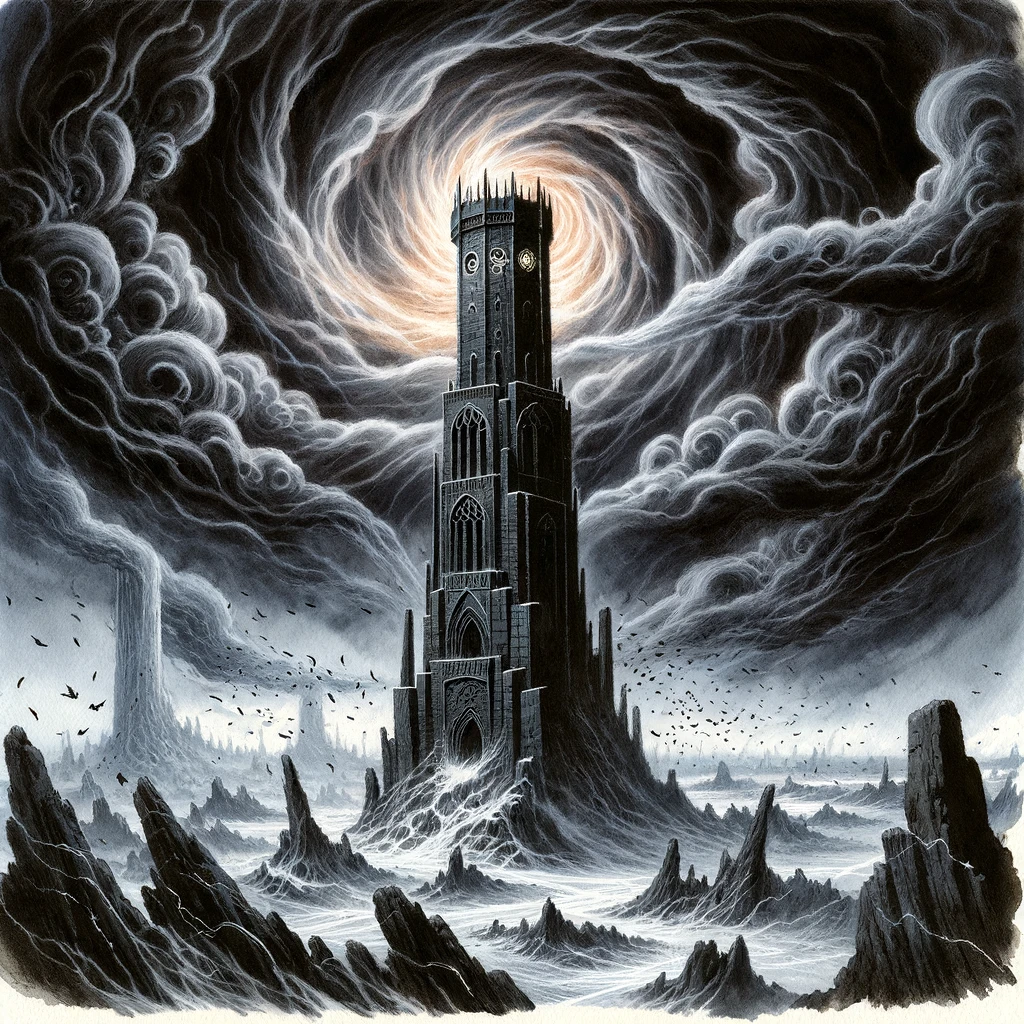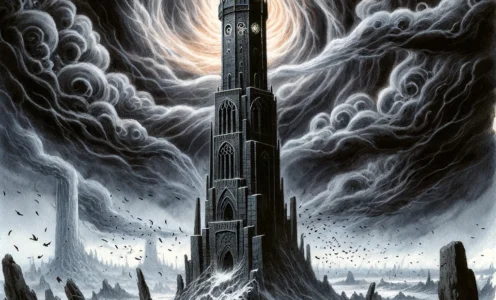Udornim’s Tower
Dust / the Storm of Annihilation
Udornim’s Tower, a remarkable edifice of erosion-resistant obsidian, stands defiantly amidst the tumultuous Storm of Annihilation. Its metallic surface, subjected to constant explosions, remains unscathed, a testament to the potent wards its creator, Axis Udornim, has placed. At the upper reaches of this tower lies a massive lens, resembling a telescope’s end but serving a far more complex purpose: it measures the fluctuations of negative energy, peering out into the vast nothingness.
Axis Udornim, the tower’s sole inhabitant, spends his days here, engrossed in his studies of the total breakdown of matter. Yet, dismissing Udornim as a mere collector of arcane trivia would be a grave mistake. His research, though seemingly esoteric, aims toward an astonishingly concrete and radical goal: the dissolution of the current structure of the elemental planes. This obsession of his traces back to his days with the Fraternity of Order’s Alchemical Division, where he was a rising star, steadfast in the belief that all physical matter in the Multiverse could ultimately be reduced to the four basic elements, infused with varying degrees of Positive or Negative Energy.
However, a pivotal visit to the Prime Material Plane shattered these convictions. Tasked with analysing the chemical composition of a crystal sphere, Udornim faced an insurmountable challenge. The black crystal of the sphere defied integration into the standard elemental framework. His failure to classify it led to a deep professional embarrassment, spiralling into an obsession that would upend his worldview. He eventually deduced that an object with the properties of the crystal sphere was impossible within the bounds of traditional alchemical theory. This groundbreaking revelation won him accolades but left him personally unmoored, his life’s work seemingly built on a flawed foundation.
For years, Udornim drifted in a fugue, his career a shadow of its former glory, until a transformative conversation with a Guvner colleague, a researcher from the Plane of Steam, reignited his intellectual passion. She proposed that the Plane of Steam had once been positioned between the Planes of Fire and Water, suggesting that the configuration of the Inner Planes was not fixed but fluid. This revelation struck Udornim with the force of an epiphany: what if the current elemental structure was merely one of countless possibilities?
Embracing this new line of thought, Udornim severed ties with the Fraternity, considering their views too narrow and conservative. He constructed his tower on the border of Dust and Negative, a locale embodying the concept of dissolution. Here, in splendid isolation, he delves into his experiments, though he occasionally entertains visitors from the Doomguard, who find his theories intriguing. While Udornim does not share their apocalyptic aspirations, he readily exchanges insights with them. Rumours even suggest collaboration between him and Citadel Sealt in developing a more potent entrope.
The tower is guarded by a small contingent provided by the Doomguard, ostensibly to protect against potential attacks. Most factions across the Inner Planes dismiss Udornim’s goals as the ravings of a madman, yet they perhaps underestimate him. To hear Udornim articulate his theories is to be drawn into a world where the implausible acquires a veneer of eerie plausibility. In the solitude of his tower, amidst the howling storms of Dust and Negative, Udornim continues his quest, seeking an understanding that might forever alter the very fabric of the Multiverse.
Adventure Hooks:
- A Rift in Understanding: Anomalies start occurring near the tower, hinting at Udornim’s success in altering elemental structures. The players must navigate these anomalies, leading to a revelation about the subjective nature of understanding and perception, as they witness firsthand the malleability of the planes.
- The Nature of Reality: A group of scholars hires the players to obtain Udornim’s research. However, as they delve deeper, they find themselves questioning the very nature of reality. The twist: they must confront the idea that reality might be more fluid and subjective than they ever imagined, leading them to ponder the implications of Udornim’s theories on their own existence.
Sourece: Fatmaninthedoorway and Jon Winter-Holt, mimir.net


